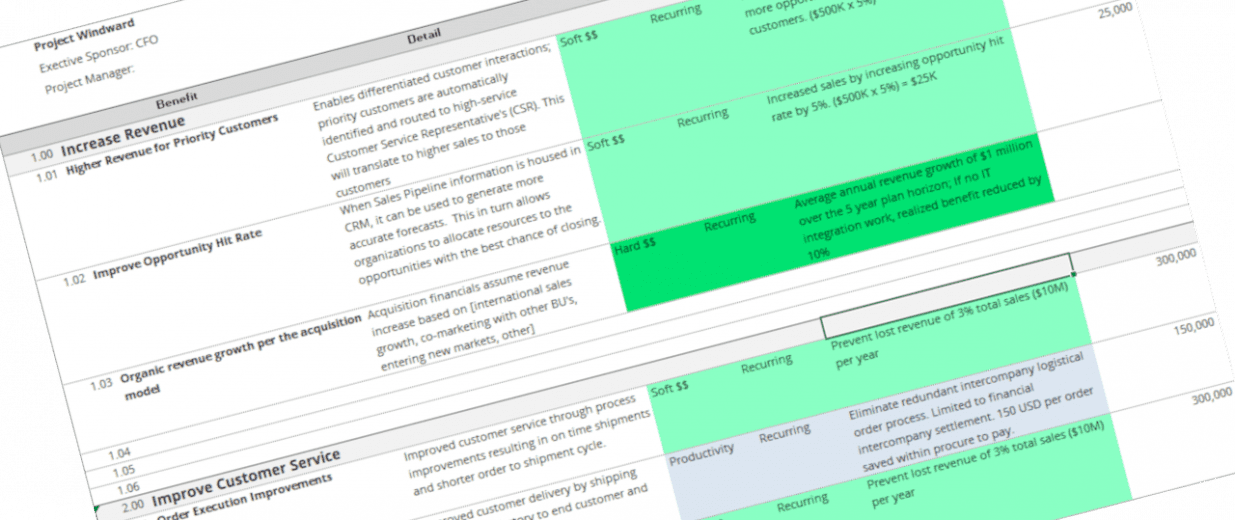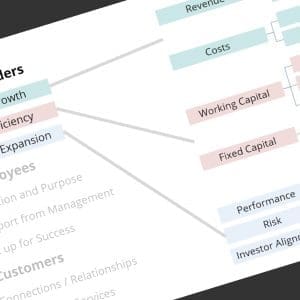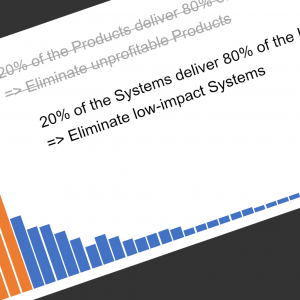That moment when your project's ROI projections meet the VP who'll actually be held accountable for them? That's where fantasy becomes reality. Here's what happened when I sat down with a Sales VP to have the ROI conversation for a six-figure e-commerce investment - and why the conversation changed everything.
Last week I released my first free giveaway – the ROI Readiness Checklist. It includes a link to a quick ROI calculator, but there’s a story behind why I built these tools. More importantly, there’s a critical lesson about the ROI conversation itself that most project teams miss entirely.
Let me tell you about a conversation that changed how I think about project justification.
When the Numbers Had to Get Real
A few years back, I was sponsoring an e-commerce platform upgrade for a mid-sized manufacturing company. The IT team had done solid work building the business case. Six figures of investment to significantly upgrade an already-revenue-generating website. The projections looked good on paper.
My job? Sit down with the VP of Sales – the person whose team would actually use this thing – and walk through the ROI model to get their sign-off.
We settled into their office, spreadsheet open on the laptop between us. I walked through the investment costs, the timeline, the technical improvements. Then we got to the returns section.
That’s when their expression changed.
“Look,” they said, leaning back in the chair. “I can’t tell you how much money we’re going to make on this. I can’t guarantee future sales. That’s not how any of this works.”
They weren’t being difficult – just honest.
The Question That Changes Everything
We dug into the specifics. The business plan for the year – we were about two-thirds through it at this point – called for $20 million in total revenue. E-commerce was currently tracking at around $5 million of that total.
I asked the question that every ROI conversation eventually has to answer: “Will this investment generate revenue that’s incremental to your plan, or will it help you capture some of the $20 million you’ve already committed to delivering?”
The difference matters. A lot.
If it’s incremental – truly additive revenue on top of his existing forecast – then we could claim it as a project benefit. But if it was just a better way to achieve numbers he was already on the hook for, it couldn’t go in the ROI model. Not as new value, anyway.
The VP thought about it. “Honestly? Probably some of both. But I can’t tell you how much is truly incremental versus just making it easier to hit my numbers.”
Then I asked the follow-up question: “If we put an additional $2 million in revenue in this model as the projected return, would you be willing to add that to your forecast? Put your name on it as a commitment?”
Long pause.
“Not as a hard number, no. Not something tied to my performance plan.”
And there it was. The moment where theoretical benefits crash into actual accountability.
Why Stakeholder Accountability Matters More Than You Think
Here’s what most project teams don’t understand: You need to get the people who own the metrics to accept the returns you’re claiming, because they’re the ones who will be held accountable for delivering them.
Not the project manager who moves on to the next initiative. Not the IT team that goes back to keeping the lights on. Not the consultant who helped build the business case.
The business owners. The VP whose compensation depends on hitting targets. The team whose quarterly reviews will reflect whether these benefits actually materialized.
This is the conversation where optimistic projections meet organizational reality. Where “just a 1% improvement could generate 10% more revenue” turns into “well, maybe, but I’m not putting that in my budget.”
And here’s the thing: There’s absolutely nothing wrong with that reaction.
What we were experiencing was the healthy, necessary process of moving from abstract possibility to concrete commitment. This VP would be living with this system long after the project team disbanded. Their people would need to incorporate it into marketing plans, drive traffic to the new features, and actually deliver results.
Of course they were going to be careful about what was promised.
Understanding Hard Benefits vs. Soft Benefits in Project ROI
This is where our conversation shifted to a more nuanced discussion. We started talking about hard benefits versus soft benefits.
Strictly speaking, a true ROI calculation requires cash returns you can measure and defend. But let’s be honest about how business actually works: tons of valuable projects don’t generate direct, measurable cash returns. They generate other types of value.
Time savings. Reduced manual effort. Improved customer experience. Better data for decision-making. Competitive positioning. Team morale and energy that’s no longer drained by broken processes.
These are real benefits, even if they don’t show up as line items in next quarter’s revenue report. You might be calculating a return on resources – time, attention, energy – rather than a pure return on investment.
The VP and I worked through this together. Could we claim productivity improvements? Probably. His team was spending hours each week manually processing orders that should have been automated. Could we quantify the competitive risk of not upgrading? Maybe. Their closest competitors had already modernized their online presence.
But we were explicit about what we could promise versus what we hoped would happen. Some benefits went in the model as hard commitments. Others were noted as directional improvements – real value that we believed would materialize but couldn’t guarantee.
What Changed After That Conversation
By the end of our meeting, the ROI model looked different than it had at the beginning. The projected returns were more modest. The timeline for realizing benefits was more realistic. Some of the splashier claims had been replaced with more defensible ones.
But something important had happened: the VP was now genuinely bought into the project. Not because we’d sold him on inflated projections, but because we’d worked together to define success in terms he could actually commit to delivering.
He understood what his team would need to do after go-live to make this investment pay off. He knew what metrics he’d be tracking and what success would look like. He’d been part of defining it, not just told about it after the fact.
The project moved forward. And when it launched, his team was ready to make it work because they’d been part of setting realistic expectations from the start.
4 Steps to Making Your ROI Conversations Real
When you’re sitting down to discuss project justification with your stakeholders, here’s what needs to happen:
Get the metric owners in the actual conversation. Not informed later. Not consulted briefly. Actively involved in defining what success looks like and what you’re willing to commit to. If the VP of Sales owns the revenue number, the VP of Sales needs to agree to the revenue projection in your model.
Push for brutal honesty about what’s incremental versus what’s already in the plan. This is where a lot of business cases fall apart under scrutiny. Be willing to have the hard conversation about what you can really claim as project value.
Distinguish between hard commitments and soft benefits. Be explicit about which returns you’re willing to put in someone’s performance plan versus which ones are directional improvements you believe will happen. Both have value, but they’re not the same thing.
Remember what happens after the project team leaves. The people you’re talking to now will be the ones who have to make this thing actually deliver value. They’ll be incorporating it into business plans, allocating resources to support it, and explaining to their leadership whether it worked. Help them understand what they’re signing up for.
Key Takeaways for Reality-Based Project ROI
- Stakeholder accountability drives realistic projections. When business owners must commit their own performance metrics to your ROI model, optimistic projections quickly become grounded in organizational reality. This accountability filter separates projects that will genuinely deliver value from those built on hopeful assumptions.
- Hard benefits and soft benefits both matter, but require different treatment. Cash-measurable returns belong in formal ROI calculations, while time savings, productivity gains, and competitive positioning represent real value that justifies investment even without direct revenue impact. Being explicit about which benefits fall into which category builds credibility and manages expectations.
- True project buy-in comes from collaborative definition of success. When stakeholders help define realistic targets rather than being sold inflated projections, they become genuine partners in delivering results. This collaborative approach creates the conditions for actual post-launch success rather than post-launch disappointment.
The Real Goal of ROI Discussions
The point of these conversations isn’t to kill projects or to deflate enthusiasm. It’s not even primarily about the numbers, though the numbers matter.
It’s about getting to a shared, realistic understanding of what you’re trying to accomplish and what it’s going to take to get there. It’s about building genuine stakeholder commitment based on honest expectations rather than hopeful projections.
When the VP of Sales looks at your ROI model and says “yes, I believe in these numbers and I’m willing to have them reflected in my plan,” you know you’ve moved from fantasy to actual business planning.
That’s when you know the project has a real shot at success.
Ready to have better ROI conversations? Download the ROI Readiness Checklist to prepare for these critical discussions. And stay tuned – this Friday I’m releasing a Quick ROI Calculator that will help you model different scenarios and have more informed conversations with your stakeholders.
What’s been your experience with ROI justifications? Have you had that moment when the projections met reality? Share your thoughts in the comments below, and if you found this valuable, join our mailing list for more insights on making digital transformation actually work.
16 October, 2025






Comments (0)